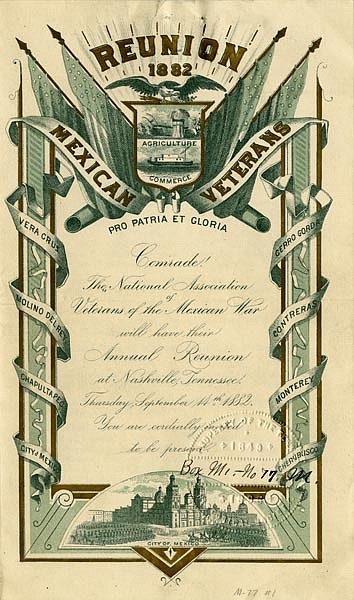Hamilton County recently commemorated Veterans Day with a ceremony at the Tennessee National Guard Armory, paying tribute to those who have served in our armed forces. On the same day, the nation - and our local community - looked backward to Armistice Day 1921 and recalled the dedication of the Tomb of the Unknown Soldier at Arlington National Cemetery. Both were emotional moments as those in attendance paused to acknowledge our blessings while simultaneously counting the cost of liberty and justice. As a part of that remembrance, we often personalize that commitment to our national ideals by picturing individuals and groups who have served, from the American Revolution through the War on Terror. However, we seldom recall the Mexican-American War.
Tennessee's and Hamilton County's involvement in the Mexican-American War go far beyond the fact that Tennessean James Knox Polk was serving as president during the war. The willingness of individuals to volunteer for military action was a nod to our history with the region. Tennesseans had rushed to the region known today as Texas during the 1820s and 1830s when Mexico first opened the territory to settlement, and potential soldiers in the 1840s had come to adulthood amidst the stories of Sam Houston and Davy Crockett. This region was primed to act when the war clouds began to form.
Polk was elected in 1844 with one campaign promise focused on the expansion of the nation by the admission of Texas as a state. On Dec. 29, 1845, Texas became the 28th state and, within weeks, Mexico and Texas, in conflict over boundary issues, were at war. The United States military was not prepared for a war. U.S. Secretary of War William L. Marcy issued a request for troops to each state based proportionally on population. Tennessee's allotment was 2,800, but 30,000 men responded, and the nickname "Volunteer State," which had first been applied to Tennessee during the War of 1812, was forever ours.
But, for the first time, Tennesseans found themselves fighting in a foreign land and confronting an enemy that far outnumbered the volunteers. As is true in all foreign campaigns, supply lines were critical to success, and costs for mounting a war continually escalated. The Mexican-American War also found that far more Tennesseans would lose their lives to diseases (measles, typhoid, smallpox, pneumonia and other illnesses) than in combat.
Also, for the first time in our national history, the telegraph provided the press almost immediate access to the battlefields. Those stirring reports created unity and patriotic fever among citizens. Names from the combat reports became the focus of conversations - Cerro Gordo, Vera Cruz and Monterrey - and the leaders of Tennessee regiments gained fame. The exploits of Gen. Gideon Pillow, Col. William Bowen Campbell, Gen. John A. Quitman and Col. Benjamin Franklin Cheatham were reenacted in schoolhouse yards and on courthouse lawns.
While the history texts provide a general overview of the war and its impact on territorial expansion, the journal notes of veterans provide us the clearest lens into the conflict. One such veteran who kept a journal rich with descriptions of his time with Company C of the 5th Regiment, Tennessee Volunteer Infantry, was Richard Mitchell Edwards, who lived in Bradley County, enlisted at Athens and served as a hospital steward in Mexico for 10 months.
"There was a scramble all over the State for permits to raise companies ... . By some kind of lottery, the different counties had to draw for the privilege of sending a company. Bradley County drew a blank, but John G. Stewart, of Rhea County, having drawn a prize .. arranged for Bradley to join the Rhea County company, provided a satisfactory arrangement could be made about officers. We were to furnish half the company and Stewart the other half, and we were to meet at old Frank Petit's, a wayside inn south of Athens. We raised our quota of forty-five men and arrived at the meeting place on October 24, but Stewart did not come till November 6, and brought only twelve men with him ... This not being enough to complete the company ... the company broke up and ... thirteen of the men from Bradley marched up to Athens and joined Captain John C. Vaughn's company."
Prepare to join Edwards over the next few weeks as we "accompany" him into the fury.
Linda Moss Mines, the Chattanooga and Hamilton County historian and regent, Chief John Ross Chapter, NSDAR, encourages readers to keep a journal.
